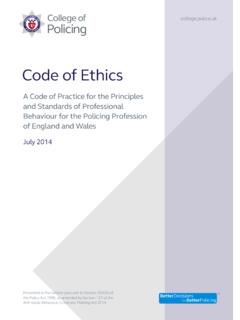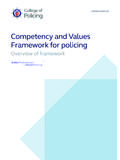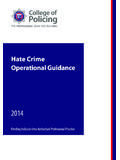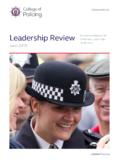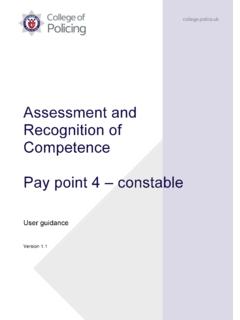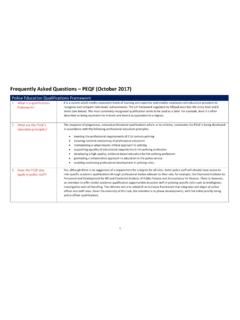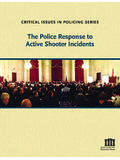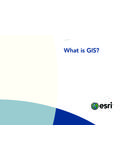Transcription of College of Policing analysis: Estimating demand on the ...
1 1 College of Policing 2015 THE PROFESSIONAL BODY FOR POLICINGC ollege of Policing analysis : Estimating demand on the police serviceSummary While reliable national data are limited, some indication of demand on police forces in England and Wales and how this might be changing is possible. There is some consistency across data sources to support the suggestion that while recorded crime has reduced, demand on the police has grown in other ways. Police recorded crime and incidents have been decreasing over the last 10 years although the trend is now slowing and some types of crime and incidents (eg, rape and public safety and welfare ) now appear to be increasing.
2 Police officer numbers have also been falling over the last 5 years. There were just under 128,000 full time equivalent officers at March 2014, a fall of 11% or around 16,000 officers since 2010. In 2014 there was one police officer for every 445 members of public, an increase of over 50 people per officer since 2010. Changing crime mix means that over the last 10 years, costs of crime for the police have not fallen as much as overall numbers of crimes. These costs are based on 2008 activity data and it is possible time spent on more costly crime has increased, particularly with relation to complex crimes such as Child Sexual Exploitation.
3 Incidents involving people with mental health issues appear to be increasing. demand on the police associated with protective statutory requirements, such as Multi-Agency Public Protection Panels appears to be increasing. There are two indications of emerging pressure on police resilience decreased levels of police visibility and increasing requests for mutual aid. This analysis has been independently peer reviewed by an academic and police practitionerEstimating demand on the police service2 College of Policing 2015 BackgroundWhile there have been a number of attempts to measure demand on the police service over the years, a lack of reliable national data has tended to result in a renewed focus on levels of recorded crime as the main measure of workload, which forces do not feel is adequate.
4 Police recorded crime, as reflected in the main performance statistics, can only represent part of the police workload. While it presents an indication of an aspect of reactive demand to which the police respond, there are many types of work, both reactive and proactive the police undertake, both as statutory duty and by common convention, which do not feature as reports of crime - and which therefore do not appear in assessments of demand using police recorded crime data. In addition, counts of crime do not show the varying levels of resource required to deal with different crimes. An experience of crime categorised within the same crime type for recording purposes can impact on individual victims very differently, and require very different responses.
5 Some crime types consume far more resource than others. Understanding the overall level of demand and work required to deal with crime, necessitates an understanding of the different amount of work involved in dealing with different Survey England and Wales data shows that crime has been on a downward trend since 1995, with Police Recorded crime figures starting to decrease from 2003/04. Despite this reduction, there is a widespread perception across forces that officers and staff are at least as busy as ever. The College of Policing has drawn on national and force datasets and local demand analysis to present the best available evidence on the demands facing the service, whether these have changed over time, and where there are gaps in knowledge.
6 A number of hypotheses around how demand might have changed were developed to help frame the analysis undertaken and are set out, along with an assessment as to the extent to which they are supported, at the end of this paper. Demands on the police can be grouped in various ways but this report considers: Public demand the traditional view of demand mainly covering calls for service or incidents to which the police respond. Protective demand more proactive work which the police are required to undertake, mainly connected to safeguarding the public. Resources allocated to these types of demands will vary depending on local context and policies.
7 Preventive work by local Policing teams is unlikely to be captured by forces or national datasets, but can reduce crime and public initiated demand on the police. Estimating demand on the police service3 College of Policing 2015 Public demand Responding to calls for service is the traditional view of demand on the police service. The activity that relates to the call will depend on a number of factors including whether the call relates to a crime or not, whether the individuals involved are vulnerable and whether there is a risk to public safety. Calls come into the police via a number of routes.
8 National data are available for those calls that come in through the emergency 999 number and data has been collected from 11 forces on calls coming in through the single non-emergency 101 number. The number of emergency 999 calls has decreased by 23% since their peak in 2006/7. Figure 1: Total number of emergency 999 calls received (all forces in England and Wales 2002/03 to 2012/13)a The single non-emergency 101 number had been introduced in all force areas by early 2012 and it may be that some of the continuing decrease in 999 calls could be accounted for by a shift to the use of the non-emergency number.
9 Although national data is not available on 101 calls, the general trend across the 11 forces who provided data in average numbers of 101 calls has been downward over the last 3 years, although last year, numbers remained stable against the previous year. There were crimes recorded by the police in 2013/14 a 21% fall since 2008/09. This downward trend can also be seen in survey results. Over the last 3 years there has been a levelling out of the numbers of crimes recorded by the police and there was no change between 2012/13 and 2013 ,000,00012,000,00010,000,0008,000,0006,0 00,0004,000,0002,000,00002002/032003/042 004/052005/062006/072007/082008/092009/1 02010/112011/122012/132013/14a For a small number of cases missing values have been interpolated or repeated from the previous yearY = -373, 687 x + 1E + 07 Estimating demand on the police service4 College of Policing 2015 Figure 2.
10 Trends in Police Recorded crime and Crime Survey England & Wales Several crime types have increased since 2012/13, including violence against the person (up 6%), shoplifting (up 7%), sexual offences (up 20%), fraud (up 17%)1 and public order (2%). In addition, to recorded crime, there were close to 1 million convicted non-notifiable crimes resulting from cases brought to magistrates courts and 34,000 Penalty Notices for Disorder issued for non-notifiable offences in the year ending December 2013. These figures are not represented in the national recorded crime statistics. While crime has fallen, there are 35,000 fewer officers and staff in 2014 than 2010, a fall of 14%.
